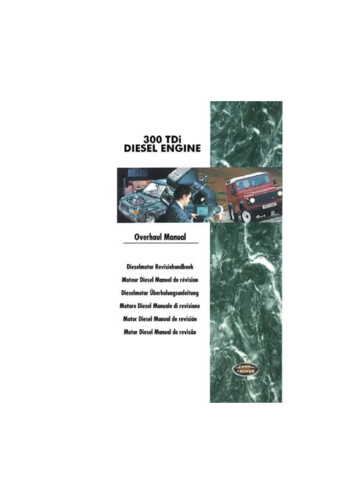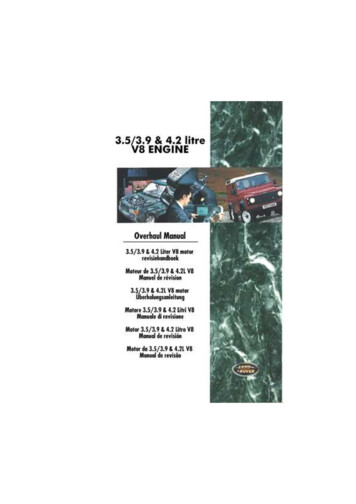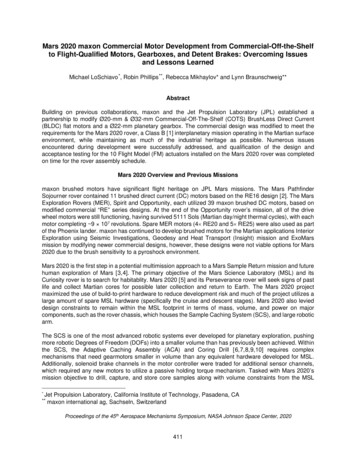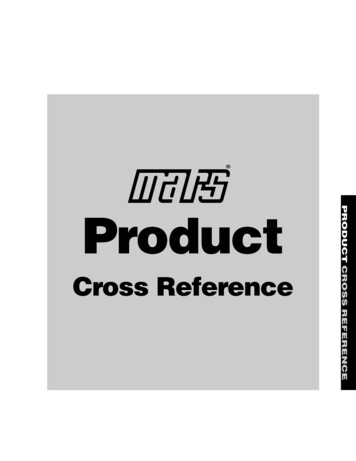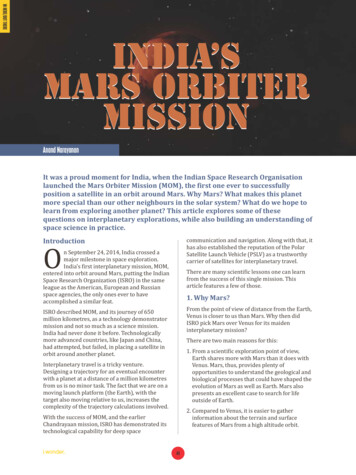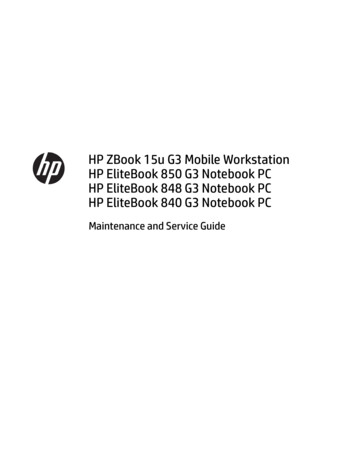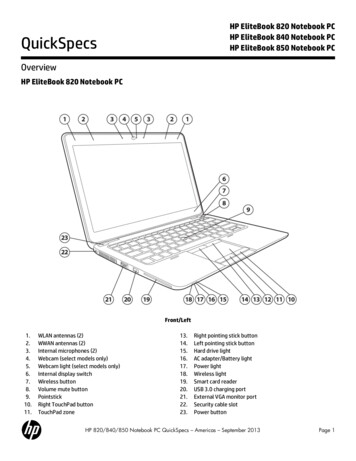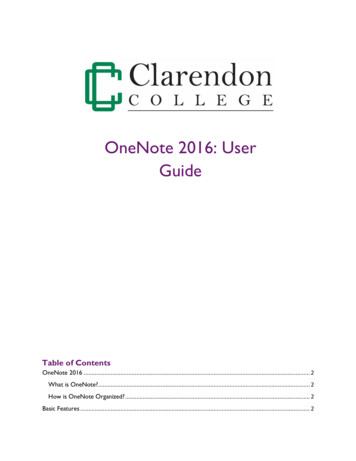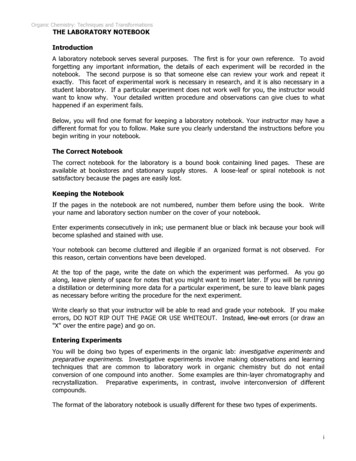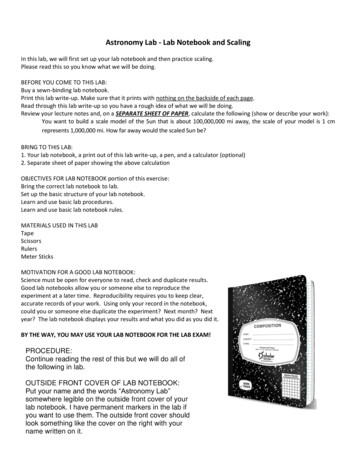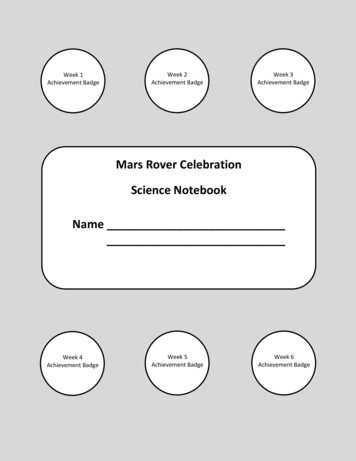
Transcription
Week 1Achievement BadgeWeek 2Achievement BadgeWeek 3Achievement BadgeMars Rover CelebrationScience NotebookNameWeek 4Achievement BadgeWeek 5Achievement BadgeWeek 6Achievement Badge
Table of ContentsLesson 1: Overview of the Solar System.3Lesson 2: Introduction to Mars .5Lesson 3:Research Tools and Skills .7Lesson 4: Investigate Mars .10Lesson 5: Selecting Team Rovers and Missions .13Lesson 6: Mission Measurements .15Lesson 7:How Do I Measure This?.17Lesson 8: Where is the Best Place to Measure? .21Lesson 9: Spacecraft Structure and Design .24Lesson 10: Landing, Moving, and Surviving .28Lesson 11: Brainstorming and Preliminary Design .31Lesson 12: Final Design .36Lesson 13: Construct Mock-Up .38Lesson 14: Manual and Skit.39Lesson15: Present Skits and Rovers .43Student Friendly Glossary .442
Lesson 1: Overview of the Solar SystemEngagement Questions:Name the planets in order, starting with Mercury.How do the planets move around the Sun?Describe the difference between rotation and revolution?Exploration Activity:Choose which bead will represent each planet. Then, tell why you chose each one.Scaled DistanceWhy did you choose this color toNameBead Colorfrom the Sunrepresent this planet?(in cm)Sun0 cmMercury4 cmVenus7 cmEarth10 cmMars15 cmJupiter50 cmSaturn100 cmUranus190 cmNeptune300 cm1. Work with your team to measure 5 meters of yarn.2. Then, tie the Sun bead to the end of the yarn.3. Use your centimeter ruler to measure how far Mercury is from the Sun (Usethe table above). Then, tie the Mercury bead at that distance (4 cm).4. In order, and one at a time, measure out the rest of the distances and tie thecorrect bead at each point.3
Explanation:Using what you have learned, draw a picture of the solar system. Don’t forget toput the planets in the correct order and label them.Evaluation:How might you describe the solar system to a friend who knows nothing about therelative sizes of the Sun and planets or the distances among them?4
Lesson 2: Introduction to MarsEngagement Question:MarsWhat I KNOW about MarsWhat I WONDER about MarsWhat I LEARNED aboutMarsExploration Activity:Look closely at your sample. Describe three things you observe about its surface.1.2.3.Think back to what you learned about Mars. What kind of surface does Mars have?Draw a picture of the surface of your sample.5
Exploration Activity:Ask your teacher to cut your sample in half. Describe what you see inside yoursample.Now, draw a picture of the inside of your sample.How have you changed your sample while studying it? Have you changed theproperties of the sample? Explain.Think about what you have learned about Mars. Could this sample have comefrom Mars? Why or why not?Evaluation:How will what you learned today about the planet Mars and about making observationshelp you design a successful mission for your Mars Rover?6
Lesson 3: Research Tools and SkillsEngagement Questions:In the 1900’s our ability to explore Mars via telescope from the Earth had reached itslimits. Combined with our space-faring abilities, becamean excellent candidate for robotic exploration.The first successful landing was NASA’s in 1976.In 2003, NASA launched the Mars Exploration Rovers (MER), which later became tobe called and .Phoenix landed so far north at a position similar to the high arctic on the Earth thatthe team knew the spacecraft wouldn’t last very long. It could only operate until theMartian or fall because the sun would dip downlow on the horizon, the solar panels would not be able to charge the batteries.Exploration Activity:Mars FactsMars’ NicknamePosition from the SunAverage Distance from the SunDiameter of Mars in kmLength of a Day (Rotation)Length of a Year (Revolution)AtmosphereRingsMoons7
Exploration Activity:What is Olympic Mons?How high is it in feet?How did Mars get its nickname?Why can’t Mars store heat from the sun?What are the ice caps on Mars made of?What is another geographical feature of Mars?Name two facts about this feature:1.2.Describe three characteristics of the surface of Mars:1.2.3.Why does Mars have seasons?8
Explanation:Based on the information you have researched about Mars, complete the VennDiagram. If more space is needed, complete your Venn Diagram on a separatepage and tape it neatly into the space below.MarsEarthBothEvaluation:Which of the informational text features you learned about today was the most helpfulto you in researching information for your Mars Rover project?9
Lesson 4: Investigate MarsEngagement Questions:What are the three most important details to help find the lost rover?1.2.3.Use the information above to design a draft of your lost rover poster. Then,create your final copy on the paper from your teacher.TitleImportantDetailsContactInformation10
Exploration Activity:Using what you have learned about identifying important details, use theresources provided to learn about Mars. Record your important details below.Remember to look for only details that would help distinguish Mars from all theother planets.1.2.3.4.5.6.7.8.9.10.11
Explanation:After each team has shared their important details and you have discussed themwith your teacher and class, write the five most important details that your classhas found.1.2.3.4.5.Evaluation:How do I know when I’ve found important information in my reading?12
Lesson 5: Selecting Team Rover MissionsEngagement Questions:As your teacher shares and discusses your ideas with the class, write the threequestions that you think would be the most interesting to investigate.1.2.3.Exploration Activity:Work with your team to narrow your possible questions to a total of three for yourteam. Write them below.1.2.3.Then, choose the one scientific question that: Has a scientific basis Is an interesting question to answer Addresses a specific problem Interests all students on your teamPut a star next to the scientific or technological question that your team has chosento answer.Teacher Checkpoint:13
Explanation:Now that you have determined your team’s scientific question, use the chartbelow to help refine your question.StepsMy Topic:What I want to know:Question:My Teacher’s ExampleMy WorkThe rings of SaturnWhere objects can orbitSaturnCan an object stay in orbitaround Saturn somewhereelse besides the rings?CheckWorkIs my question clear?Is my question specific?Can I answer this by gathering data?Teacher Checkpoint:Evaluation:Why is it important to ask valid (good) scientific questions?14
Lesson 6: Mission MeasurementsEngagement Questions:Your teacher’s scientific question has to do with Saturn:Can an object stay in orbit around Saturn somewhere else besides the rings?Brainstorm some possible solutions to this scientific question to share with yourteacher and your class.Solution #1Why is this solution a good idea?Solution #2Why is this solution a good idea?Solution #3Why is this solution a good idea?Solution #4Why is this solution a good idea?15
Exploration:Using your teacher’s example as a guide, brainstorm your team’s scientific ortechnological question on the worksheet that your teacher will give you. Narrowyour solutions down to one and record it below:Mission QuestionsChosen MissionHow might thishappen?What else couldhappen?Have I thought thisthrough?What measurementswill I need to make tocarry out my mission?Does this missionmake sense? Whatproblems could causemy mission to fail?Evaluation:Why is it important to write your scientific question so you can answer it using data?16
Lesson 7: How Do I Measure This?Engagement Questions:Why was it a bad idea for the king to walk around the queen to measure for herbed?Why did the bed end up being too small for the queen?How could this problem have been avoided?Exploration Activity:The reason to do an experiment is to answer a question. The question that you andyour team will answer is:How is the size of the crater related to the size of the itemand the height from which it is dropped?During this experiment you will learn how craters form. To start, we will need threeobjects that we will pretend are meteors. With your team, circle the three objectsyou will use:marbleping pong ballgolf balldried peasgumballcinnamon imperialSo that we can get good results, we will need to drop each object from the sameheight. Circle the one height that your team will drop your objects from:30 centimeters50 centimeters70 centimetersThen, use this information to fill in the shaded parts of the table on the next page.17
Exploration Activity Cont.:Diameter of Crater fromDrop HeightItems that will be dropped 1.2.3.Teacher Checkpoint: Once you and your team have completed the shaded areas,ask your teacher to check it over. Teacher’s Initials:Now that you have correctly created your table, begin the experiment bydropping the first item from the height your team selected. Then, carefullyremove the object from the pan using the tongs.With your team, examine the crater. Use your ruler to measure the diameter ofthe crater (in cm). The diameter is the distance across the widest part of thecircle.Repeat these steps with your two other objects. Each time:1.2.3.4.Drop the next object into the pan from the correct height.Carefully remove the object with the tongs.Measure the diameter of the crater left behind.Record the diameter of the crater correctly on the chart.When you have finished, we will need something to compare it to. Place an Xover your Drop Height and work with your team to circle a different number.Then, write this number in the third column of your table above.30 centimeters50 centimeters70 centimetersTeacher Checkpoint: After you and your team have circled your second DropHeight and written it in the third column of your table, show it to your teacher.Teacher’s Initials:18
Exploration Activity Cont.:Now that your chart is complete, we need to draw conclusions from theinformation we gathered.Which item created the biggest crater? Why?Using the diagram below, choose one of your objects and describe in detail whatthe crater looked like after the object was removed.How does the crater change as the height an object is dropped from changes?19
Explanation:What scientific or technological question will your team answer? (Go back throughyour Science Notebook and copy it from Lesson 6.)Our Team’s Question:Now, think about the experiment that you conducted and how you measured thecraters to help answer this question.What things will you measure with your own rover experiment:1.2.3.List three ways you and your team will take these measurements in your ownexperiment?1.2.3.Evaluation:Why are taking accurate measurements critical to your Mars rover mission?20
Lesson 8: Where is the Best Place to Measure?Engagement Questions:What is your team’s scientific or technological question?Why is it important to select a good landing site for Curiosity?Exploration Activity:Explore Gale Crater and complete the chart:Weather/ClimateTerrainConstantsVariablesWhat are somecharacteristics of theclimate on Mars ?How does theterrain differ fromthe terrain on Earth?How is it the same?What elements willremain the samewhen you test yourteam’s question?What elements willchange when youtest your team’squestion?21
Exploration:Based on what you have learned about Gale Crater, name 3 reasons why it was agood place for Curiosity to land.1.2.3.Now, use Google Earth Mars to locate a place for your team’s landing site. Use aseparate pieces of paper to research the following locations: Eberswalde Crater Holden Crater Mawrth Vallis Olympus Mons Home PlateOnce you have completed your research and decided on a landing site for yourrover, complete the following details:Chosen Landing SiteExact Location on MarsDescription of terrain and climate at this location22
Explanation:Now that you have gathered the important details of your team’s landing site,record that information on a piece of chart paper.Along with the landing site, exact location on Mars, description of terrain andclimate, be sure to include:Three reasons why your team chose this site1.2.3.How will this landing site help your team to answer your scientific question?1.2.3.Evaluation:How did you select the place for your Mars rover mission? Did you have to modifyyour mission because of the location you chose?23
Lesson 9: Spacecraft Structure and DesignEngagement Questions:3Facts2Questions1OpinionExploration Activity:Rover CommunicationScenario #1MaterialsScenario TransmitterGroundReceiver/TransmitterScenario #1Scenario #2TrialsTrial 1Trial 2Trail 3Trial 4Trial 5Total Seconds on Targetin two minutesTrialsNumberTotal Seconds on Targetin two minutesTrial 1Trial 2Trial 3Trial 4Trial 524
Exploration Activity:Spacecraft DesignBefore building:What is the purpose of your space probe (use your article to help you)?What three things will you need to think about when you build your space probe?1.2.3.During Building:What design elements will you build to make sure that your probe always landsbottom down?After Building:How does your team’s design compare with NASA’s design?Testing:Drop your probe from the following heights and record your observations.TrialHeightTrial 11 footTrial 22 feetTrial 33 feetScientific Observations25
Exploration:Research and InvestigationTeam ng correct terms, gives theOperator directionsOperates the mouse andkeyboardKeeps all team members focusedand on taskMonitors the noise level of thegroup and watches the timeRecord their data in their ScienceNotebooksNameEveryoneHow Spacecraft are BuiltHow Spacecraft Enter an Atmosphere and LandScientific Instruments Spacecraft May CarryOther Facts I found: (If you need more space, record your data on another sheetand tape it into your Science Notebook.)26
Explanation:StatementTrue or False?How do you know?Astrology and astronomy are basicallythe same thing.Rovers communicate with Earth usingradio waves.Since we already went to the Moon, itis easy to send people to Mars.Because Mars has a thinneratmosphere than Earth, the shape of aspace probe is critical for landing onMars.Although spacecraft are constructedfor specific missions and purposes,they are all designed and built usingthe same process.Evaluation:What attributes will my Mars Rover need to:Get to MarsCarry out its missionSend the data back to Earth?27
Lesson 10: Landing, Moving and SurvivingEngagement Questions:Different ways we could land a rover on Mars:1.2.3.Ways to Land a Rover on MarsRetro Rockets andLanding LightsLandingStrategyRoverSizesmall to midsizeLandingSpeedlands at under 2 mphthen gently lowered tothe ground by cablesExploration Activity:My chosen Landing Strategy:How My Strategy Can be SuccessfulHow My Strategy Can be Problematic28
Exploration Cont.:How My Strategy Can be SuccessfulHow My Strategy Can be ProblematicThe Landing Strategy my team decided to use:We picked this landing strategy because:1.2.3.Next, work with your team to decide how your rover will move around once itlands on Mars.29
Exploration Cont.:How will your rover survive the harsh conditions on Mars?ColdTemperatureson MarsRover PowerSourceOur RoverDust in theEnvironmentEvaluation:Why is the method you chose for landing your Rover on Mars the best one for yourmission?30
Lesson 11: Brainstorm and Preliminary DesignEngagement Questions:TheEngineeringDesign ProcessWhy do we need the Engineering Design Process?How will you use the Engineering Design Process when you build your Marsrover?Engineering Design Process Image courtesy of NASA31
Exploration Activity:Team Information:Who are the members on your team?What is your team name?What will each person do to help build your Mars Rover?Team Member’s NameHow will they help?Teacher Checkpoint:32
Exploration Activity:Work with your team to draw a sketch of what your rover will look like. Be sureto keep your mission in mind. Tape or staple extra pages into your ScienceNotebook as needed.33
Explanation:Show your completed concept map to your teacher for approval. Once it isapproved, tape it neatly in the space below. (You may need to fold it so it willfit.)Teacher Checkpoint:34
Evaluation:Which step of the Engineering Design Process was the most difficult for your team?What made this step so challenging for you?Elaboration (optional):Once you are finished building your Mars Rover, make sketches of its top, front,and side views.How does your original sketch compare with your actual prototype? Whatchanges did you need to make? Why?35
Lesson 12: Final DesignEngagement Activity:Engineering CareersAerospaceExamples of this CareerDesigning airplane engines,ChemicalCivilElectricalMechanicalCreating a new part for a bicycle,Mars Rover CuriosityExploration Activity:Career:Career:Career:Career:How this CareerContributes toCuriosity:How this CareerContributes toCuriosity:How this CareerContributes toCuriosity:How this CareerContributes toCuriosity:36
Exploration:My TeamMy Career AssignmentUse your Science Notebooks and additional paper to collect the followinginformation:ooooMission (Scientific or Technological question to be answered)Specific Location of the MissionRequirements of the roverFeatures of the roverOnce you have gathered this information, work with your group to finalize yourrover design. Then, copy it neatly onto a piece of chart paper. Be sure to stateyour mission, tell your specific location, and label your requirements and features.When you are finished, work with your team to write a caption for your poster.Evaluation:How will creating a prototype of your rover help you prepare for the Mars RoverCelebration?37
Lesson 13: Construct Mock-UpEngagement Activity:EngineerCharacteristics of a Successful ScientistDesignerProject ManagerEvaluation:How does assigning a different job to each member of your team (designer, scientist,project manager, engineer) help you to complete your Mars rover mission?38
Lesson 14: Manual and SkitSTEP 1:With your team, brainstorm ideas for your skit. As you share ideas, answer thefollowing questions:1. What is the purpose of our skit?2. Who is our audience?3. Should our skit be PROFESSIONAL or INFORMAL? (Circle one)Explain whyUse the information in the table below as you write your skit to ensure you arewriting for the correct audience.ProfessionalInformalLengthshort or longshortPreparationlarge amount of timevery little preparation timeVisual Aidsfrequently used, polishedsometimes usedRehearsalsYESNORefinementsYESNOAudiencelarge: adults, expertssmall: family, friends, classmatesVocabularyacademic, consistentlanguage often varies from oneperformance to the nextTeacher Checkpoint:39
STEP 2:Now that you have the idea for your skit, it’s time to capture the details:Skit Title:Props Needed/Team member responsible:PropTeam Member ResponsibleBackdrop: YES NOIf YES .What will the backdrop be?Who will design backdrop?What role will each team member play in the presentation?Team MemberCharacterTeacher Checkpoint:40
STEP 3: OutlineUse your own paper to create your outline. Your outline doesn’t have to followthis list exactly, but be sure to include all the major categories listed below.I.Basic Informationa. Introduce our Teamb.II.Purpose/Goals of the Rover Missiona.b.c.III.Important Facts/Notes to Tell Audiencea.b.c.IV.Rover Designa. Landing on Marsb. Overcoming Conditions on Marsc. Powering & Controlling the Roverd. Communicating with Earthe. Special InstrumentsV.Other Information (if needed)a.b.VI.ConclusionTeacher Checkpoint:41
Explanation:To make a large project easier, share the work. Using the chart below, record theduties each person on your team will be responsible for.Team MemberResponsible For Teacher Checkpoint:Evaluation:What are the key elements of an effective presentation that your group should keep inmind when writing your Mars Rover skit?42
Lesson 15: Present Skits and RoversEngagement Questions:Great ideas I heard from other teams that I can borrow and include in ourpresentation: Evaluation:How did listening to the other teams present help you to improve your own Mars roverpresentation? Be specific.43
Student Friendly GlossaryBolded words are the key terms that you will learn throughout the Mars RoverCelebration unit. Words that are not bolded are supplemental words to help youbetter understand the content.accurate: measured or calculated precisely and correctlyaerodynamic: having qualities that make something move easily through the air usingless fuelapply: to use what you have learned for some purposeastrology: the belief that the positions and movements of the stars, moon and planetsmight influence events and the lives and behaviors of peopleastronomical unit: the average distance from the Earth to the Sunastronomical: (meaning 1) something related to outer space(meaning 2) a very large number or amountastronomy: the scientific study of stars, planets and other matter outside the Earth’satmosphereatmosphere: the mixture of gases that surround a planetattribute: a quality or feature, usually one that is considered good or desirableavionics: the electronics that navigate and control a rover, airplane or spacecraftbrainstorm: a group approach to problem solving that starts by generating new anddifferent ideasbus: the body of the rover or spacecraft44
calculate: to solve a problem or figure out an answer using numberscharacteristic: a quality or feature typical of something or someone that is easy torecognizechassis: the frame of a vehicle to which the other parts are attached (wheels, engine,body)climate: the typical weather conditions in a particular areacollaborate: working together in a group to solve a problemcomposition: the chemical make-up of an object or surfaceconcise: shorter than the original, with no unnecessary wordsconditions: the weather at a particular time or place and how this weather affectseverything and everyoneconsider: to think about something carefullycontrol: a test group in which the variable is not altered. The control helps scientists seewhat difference, if any, that a change in the variable makescore sample: a round piece from the inside part of something (a planet, a tree, a glacier,etc ) taken out using a hollow drillcrater: a round hole in the ground made by something that has fallen on it or by anexplosiondiagram: a simple drawing or plan that shows exactly where something is, whatsomething looks like or how something workseccentricity: a way to measure how round or oval a planet’s orbit isellipse: the oval-like shape of an orbitengineering: the work involved in designing and building things such as roads, bridges,and machines45
evaluate: to judge or decide how good, useful, or successful something isfalsify: showing that a theory or model is wrong by making measurementsflow: the steady movement of water, electricity, traffic, people, ideas, etc. from oneplace to anotherfocus: the location of a star within a planet’s orbitgenerate: to produce, create, or come up with somethinggeology: the study of the rocks and soil that make up the Earth and other planets, andhow rocks and soil change over timehypothesis: a good guess about something that has not yet been proven to be trueimpact (meaning 1): when one object strikes another(meaning 2): the effect or impression something makesinference: something you think is true based on information that you have and whatyou already knowingenuity: cleverness or talent for inventing useful things and thinking of useful newideaslight minute: a way of measuring very large distances, much bigger than miles orkilometersmain idea: the overall idea of a paragraph or text; a brief statement of what the textsays about the topicmanager: a person whose job is to direct or control a business and to deal with thepeople, equipment, money and problems of that businessmeasurement: a number that represents the length, weight, temperature, speed, etc.of somethingmission: the clearly stated main purpose or goal for a trip or a projectmock-up: a non-working scale or full sized model of something46
model: a larger or smaller scaled copy of an objectorbit: the oval path that an object takes in space around a star or planet. Moons haveorbits around a planet; planets have orbits around a star.paraphrase: to state in a shorter, clearer, or different way what someone else has saidor writtenplagiarism: copying an idea or the written work of someone else without saying wherethe information came fromplanet: an object that orbits a star that is round in shape owing to its own gravityplausible: something that makes sense and may be truepower system: the system that produces and distributes electricity on a vehicle,building, etc prediction: a good guess about something that may happen in the futureproblematic: difficult to deal with, fix, or solveprocess: a series of actions or steps that are taken in order to do somethingprofessional: well-trained, well-made or well-doneprop: a small object such as a book or a telephone used in a play or skitprototype: the first model made of something used to test the design or to show whatthe actual item will look likerefine: to improve something over time by making small changes to itrehearse: to practice something (like a play or a concert) for a public performancerepresent: (meaning 1): to stand for or be something else(meaning 2): to show somethingresearch: to study something carefully, to get all the necessary facts and information47
revolution: a circular movement around somethingrotation: when something moves in a circular movement around a central pointrover: a robotic Mars surface lander that can move on the surfacescale: an exact copy of an object that is either larger or smaller than the originalselect: to choose carefullysolar system: a solar system is made up of a star and the planets that go around it. Asolar system also includes things such as moons, comets, asteroids and space rocks.solution: a way of dealing with a problem or a difficult situationstandardized: when all of a particular type of item are made to be the same as eachothersummarize: to make or write a short statement that gives only the main informationand not the detailssurface: the outside part or top layer of somethingsuspension: parts attached to the wheels of a vehicle that make it ride smoother onrough roads and surfacessystems engineering: the type of engineering used when designing very complex thingstechnology: the methods and machines used to make things and solve problemstelemetry: the system used to transmit data back to the earthtemperature: a measure of how hot or cold something is.terrain: an area of land with a particular geology (rocky terrain, desert terrain)texture: how smooth or rough something is.48
thermal control system: the system that keeps your rover from getting too hot or toocoldtopic: a subject that people talk or write aboutvalid: something that is reasonable or makes sensevalidate: to prove that something is true or correct by testing it several times usingscientific experimentsvariable: something that changes or can changeVenn Diagram: a picture of two or more overlapping ovals (circles) that shows howthings that are being compared are similar and different49
Mars What I KNOW about Mars What I WONDER about Mars What I LEARNED about Mars Lesson 2: Introduction to Mars Exploration Activity: Look closely at your sample. Describe three things you observe about its surface. 1. _ 2. _ 3._ Think back to what you learned about Mars.
